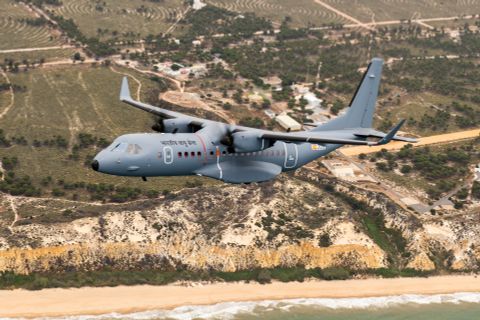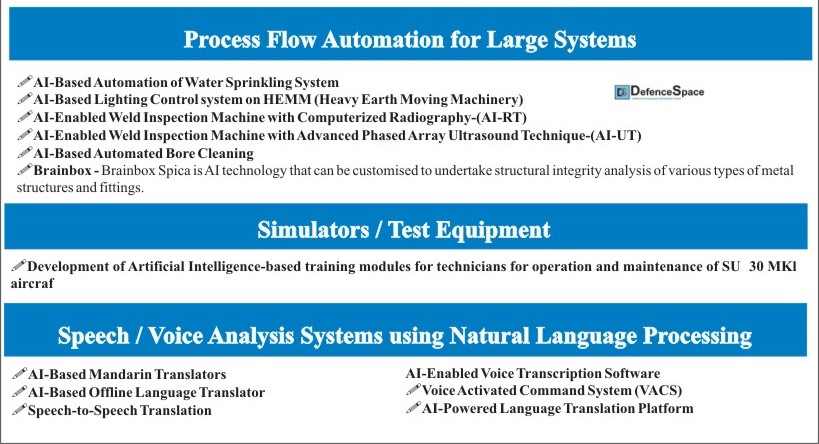Drones - Force Multiplier in Combat and Commercial Applications
(Part 2 of the Blog Series)
BY RITIKA BEHAL
Drones or Unnamed Aerial Vehicles (UAVs) will be the major force multipliers in the future battles, as they are not only precise in striking but are also economical to develop and maintain as compared to most of the other conventional war fighting machines. In recent years, the capabilities of UAVs have been employed over a larger spectrum of Combat and Civil/Commercial domain which in turn has driven and revolutionized the UAV market globally including that of India.
Overview of India’s Military Drones Arsenal
In the Indian context, the Indian Armed Forces has long been operating the imported Israeli Searcher and Heron drones for C4ISTAR roles and even possesses anti-radiation suicide drones from Israel itself, however they do not as yet have armed or missile firing drones their inventory. Refer Table.
Source: MoD and Compiled by https://thedefencespace.com/
However, India is now looking to change this scenario. The Indian Government is not only emphasising on procuring of armed and advanced drones, but also encouraging indigenous development and production.
Considering last year itself, the Indian Army, Navy, and Air Force signed multiple contracts worth over Rs 500 Crores in the sphere of drone technology with the focus on Indian companies.
Leading the three Services on the new contracts signed is the Army, which has signed three separate deals for various types of drones. This included two deals worth over Rs 200 Crores for two sets of Swarm drones with Indian start-ups — Bengaluru-based NewSpace Research and Tech, with few of them being inducted already.
The Army has also placed order for over 100 tactical Indo-Israel kamikaze drones worth $20 Million, used in the Azerbaijan-Armenia conflict, to enhance its operational capability.
These drones will be manufactured in Bengaluru by a joint venture between Israel’s Elbit System and India’s Alpha Design, which is now part of the Adani Group. Besides, the Army has initiated a Make II case Autonomous Surveillance and Armed Drone Swarm (ASAD-S).
The Indian Navy has also placed a large order with an Indian joint venture firm for specialised drones.
Besides, the ‘blue water’ force also has taken on lease two Sea Guardian drones from US to enhance surveillance over the Indian Ocean Region (IOR).
The two non-weaponised MQ-9B Sea Guardian drones have been leased for one year with an option of extending the period by another year.
India’s Military Drone Market on the Rise
In addition to the above already signed orders, India have also initiated with additional procurement of more UAVs and UCAVs for both reconnaissance and punitive attacks in near future.
Rather, last year in the month of October itself, the Government has issued several Request for Information (RFIs) and Request for Proposals (RFPs) for over 2000 drones for the Armed Forces that too under ‘Make in India’.
It is projected that the Indian Armed Forces plan to induct 5,000 UAVs (including of over 200 armament-capable UAVs) in next 10 years. at a cost of over $3 billion.
These include high altitude long endurance (HALE) UAVs, MALE UAVs, vertical take-off, and landing (VTOL) UAVs and tactical UAVs going all the way down to mini- and micro-UAVs for the Indian Army.
Besides, over next 15 years, Indian Army plans to induct UAVs down to the battalion level, while Indian Air Force aspires to have at least six 18-fleet squadrons of both armed and unarmed UAVs.
Some of the RFIs / RFPs issued in last 2-years in this segment are mentioned below:
Source: MoD and Compiled by https://thedefencespace.com/
Further, this year the Mod have come out with a RFP for 130 Nos. of tethered Drone Systems under Emergency Procurement through Fast Track Procedure (FTP) category under ‘Buy (Indian)’ category.
Also, the Indian Ministry of Defence (MoD) is currently negotiating with Israeli Aerospace Industry (IAI) to not only upgrade the existing fleet of 90 Heron drones of the Armed Forces, but also arm them with laser-guided bombs, precision-guided munitions, and anti-tank missile under “Project Cheetah.”
As of now, this upgrade program is at contract negotiating committee level.
Besides, India has also decided to go in for 31 American MQ 9B armed drone worth $3 Billion with 10 for each defence service. The deal has reached advanced stage of negotiation and is expected to be signed soon.
Indigenous Push
While, India has always been dependent on import from countries like Israel for its requirements of drones, however the dependence is slowly making way for indigenous systems with India has been successful in developing its own UAVs through public sector units and private companies.
Some of these include Rustom, Nishant, Panchi and Netra, while micro and mini-UAVs are registered as Black Kite, Golden Hawk, Pushpak, Imperial Eagle and Sly Bird.
HAL is also developing TAPAS BH-201 drone, which will be used for missions by the armed forces.
Further, around 76 TAPAS drones will be inducted into the armed forces - Army (60), Air Force (12) and Navy (4).
Notably, there are more than 150 drone manufacturing companies and start-ups bourgeoning in India, indicating the wide scope of evolution of the drone and UAV ecosystem, going forward.
Some companies such as TATA, Idea Forge, MKU, TAAL, Speck, Alpha Design, Dynamatic Technologies, Coral Digital Technologies etc. have taken steps to develop UAVs on their own or with technology collaborations with global OEMs and have even been able to get orders from the Armed Forces as mentioned above.
Further, in order to promote indigenous manufacturing of drones, the Indian Government recently banned the import of drones except for R&D, defence, and security purposes.
The order issued by the Directorate General of Foreign Trade or DGFT under the Ministry of Commerce and Industry on February 9, 2022 prohibits with immediate effect, the import of drones in Completely-Built-Up, Semi-knocked-down or Completely-Knocked-down forms.
The order also says that import of drone components is “free” implying that no permission is needed from the DGFT.
Local manufacturers heavily rely on imported drone components to assemble their own drones.
This will prove advantageous for them and will permit them to import parts likes diodes, chips, motors, lithium-ion batteries, etc. easily.
Besides in August 2021, the Government brought out liberalised Drone Rules, 2021 which reduced the number of forms to be filled to seek authorisation from 25 to five, besides offering various production-linked incentive scheme for drones and drone components.
All these initiatives are bound help private companies to enter the drone manufacturing arena and develop cutting-edge technologies required by the Armed Forces while also expediting the entire manufacturing process.
And, not to forget the recently issued tenders for UAVs/UCAVs for the Armed Forces envisages sourcing these from Indian companies, thereby offering lucrative opportunities to the Indian defence industry.
Domestic Manufacturing Potential for Military and Commercial Drones
Amidst all these indigenous developments in the Indian drone industry and procurements in pipeline, as per a recent report by E&Y and FICCI on “Making India the Drone Hub”, India has the unique opportunity to realize approximately INR 1.8 Lakh crore of aggregate domestic manufacturing potential through focused implementation of drone indigenization projects, across defence, commercial, homeland security and counter UAV sectors.
The Indian UAV market comprising of both commercial and defence was around Rs 2,900 Crores up to 2020, and is expected to see a massive growth reaching Rs 81,600 Crores by 2025 growing at a CAGR of 80%, followed by a CAGR of 35% in 2025 to 2030 to reach Rs 1,77,000 Crores. Refer Fig.
Source: FICCI & E&Y Report on ‘Making India the Drone Hub’ and Compiled by https://thedefencespace.com/
Notably, the commercial UAV market in India is currently experiencing exponential growth, becoming more widely utilized in the following sectors: agriculture, forestry, mining, power, railways, construction, highways, e-commerce, homeland security, smart city and urban development projects, and media.
Applications include site inspections, surveillance, and monitoring to capture and disseminate real time data.
As for the military segment, India’s focus would predominantly revolve around swiftly increasing the unmanned and combat UCAV inventory with the focus on indigenization in mind.
Thus, apart from manufacturing, opportunities exist in the areas of drone components, hardware, software applications, and value-added components.
As of now, India is hugely dependent on US, China, and Europe for specific components for drones like BLDC motors (brushless motors) and electronic controllers etc.
It would not be wrong to day that the military drone market has robust growing prospects in coming years.
Summing-Up
Evidently, the future belongs to the UAVs, and this holds true not only for the defence segment but also for civil and commercial segment as well wherein huge opportunity is seen in coming years due to technological advancements and various applications.
The overall Indian UAV market growth will be fuelled up by surveillance, patrolling and reconnaissance required in various sectors and also owing to security concerns predominantly terrorist threats, border intrusion, and rise in domestic crime rate.
This growing diversity of markets and applications in turn will create substantial opportunities for UAV vendors, from large defence contractors to small service companies.
Besides, the rise of the drone manufacturing industry in India will result in significant manufacturing resulting in spin-off across the subcomponent value chain, right across motors/propulsion systems, payloads, communication modules, batteries/power systems, propellers, assembly, navigation systems and airframes.
Thus, impetus should now be to self-manufacture these components.
To sum up, the India UAV market which is seen to be in its early stages of lifecycle is all set to fly high in coming years.
To Read Part 1 of this Blog Series click on: https://thedefencespace.com/drones-force-multiplier-in-combat-and-commercial-applications/





2 thoughts on “Drones - Force Multiplier in Combat and Commercial Applications (Part 2)”
Comments are closed.